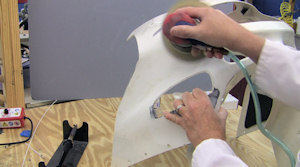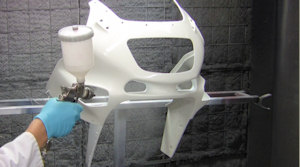We help people repair plastic
How to Repair Motorcycle Fairings with PlastiFix
Instructional Video
Step-by-Step Instructions
Step 1
Motorcycle fairings are often discarded because of small cracks in the motorbike fairing. Replacement fairings may not be available or they may be too expensive. We will recreate the missing piece on this side so that it matches the piece on the opposite side.
Clean the damaged area. Some contaminants, like tar or grease or sticker adhesive, will not come off with soap and water. A Polyvance plastic cleaner will help remove these contaminants without attacking the plastic. Use a clean cloth or paper towel and wipe in one direction to avoid recontaminating the surface.
Step 2
Use a rotary tool with a teardrop shaped cutting bit to remove the paint where the PlastiFix will be applied. Grind away some of the plastic so that after the PlastiFix is applied, the surface will be flush with the surrounding plastic.
Step 3
Apply aluminum body tape to the backside and use a body spreader to get a good seal of the tape to the plastic fairing.
Step 4
Use a body spreader to help put a small bend on the edge of the tape. This will help keep the PlastiFix contained.
Step 5
Sprinkle a layer of the PlastiFix powder onto the tape and the repair area. It may help to get the piece as horizontal as possible to keep the powder from running off of the area. Once the powder is applied, squeeze the PlastiFix liquid applicator bottle and apply liquid on top of the powder until the powder is saturated.
Continue layering the powder and liquid until the desired thickness is achieved.
Allow plastifix to cure fully before removing the tape.
Step 6
On the backside, we added additional strength to the repair with fiberglass tape. Cut a piece of fiberglass drywall tape that will fit the repair area and press the tape into place.
Just as was done on the opposite side, layer the powder and liquid until the desired thickness is achieved. Allow PlastiFix to cure fully.
Step 7
The plastifix will be rough and will need to be shaped and contoured. A pencil and ruler will assist with grinding to the proper shape.
Step 8
Use die grinders and sanders to reshape the plastifix to the proper shape.
Step 9
Tape a piece of paper to the undamaged piece and use a pencil or a crayon to get a rubbing of the shape.
Step 10
Cut the shape out of the paper and flip the paper over. This is the contour that we need to transfer to the damaged part.
Step 11
Tape the paper into place. This gives an idea of how much filler will need to be applied.
Step 12
Mix and apply Flex Filler to the area until the height of the filler follows the contour of the paper.
Step 13
Allow time for the Flex Filler to fully cure and then sand the filler to the correct contour.
Step 14
You can see here that excess material has been built up and needs to be removed.
Step 15
Use high-speed die grinder with a cutting burr or a rotary tool with a teardrop shaped cutting bit to remove excess repair material. Continue removing the excess repair material until the desired thickness is achieved.
Step 16
The thickness now closely matches the original thickness and is ready to prime and paint.
Step 17
Sand any area where primer will be applied with 320 grit sandpaper.
Step 18
Apply a high build flexible primer surfacer and allow time for it to dry.
Step 19
With 320 grit sandpaper, sand the primer until the entire part has a smooth finish that is ready for a top coat.
Step 20
Apply the top coat according to the paint manufacturer’s recommendations. Here, we are applying a basecoat and clearcoat.
Products Used For This Repair





















